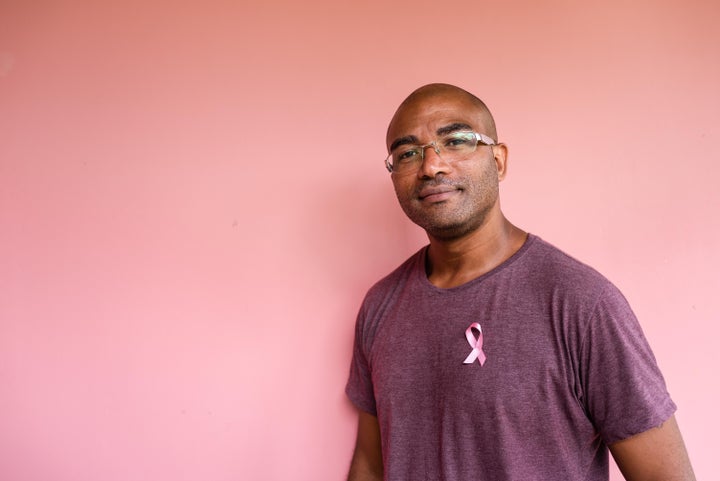[ad_1]
Breast cancer is a condition that’s usually associated with those who are women. The disease occurs in more than 280,000 women in the United States each year and is the topic of study at many research hospitals.
But it’s an oft-overlooked topic when it comes to males, who also can get breast cancer — though it occurs at a much lower rate.
There are roughly 2,000 cases of male breast cancer each year, according to Dr. Kathryn Ruddy, a breast oncologist at Mayo Clinic Comprehensive Cancer Center in Minnesota. That’s a fraction of the occurrence in women, but is still a significant amount.
For a few reasons, breast cancer in men is often diagnosed at a later stage than it is in women.
“Male breast cancer tends to be more aggressive and locally advanced at diagnosis, compared to female breast cancer,” said Dr. Nour Abuhadra, a breast medical oncologist at Memorial Sloan Kettering in New York.
“I think some of that may in part be due to screening mechanisms we have in place for female breast cancer, where that doesn’t really exist for male breast cancer,” Abuhadra added, referring to tests like mammograms, which women get every year or every other year starting at about 40.
Plus, since breast cancer in men is a rare diagnosis, it’s not front of mind for most people — and many males don’t even know they can physically develop breast cancer. Additionally, there’s a stigma associated with the phrase “breast cancer” — even though there should be no embarrassment with this diagnosis.
All of this means it’s crucial that those who are men are aware of the signs of breast cancer and know if they have any risk factors. Here, experts share the warning signs of male breast cancer and what to know about the disease.
A lump could be a sign of breast cancer.
A new mass in the chest area is a common sign of breast cancer, Ruddy said. This can feel like a small, pea-sized lump and is often the sign that leads to a cancer diagnosis in men.
“Really, breast cancers [in men] aren’t diagnosed until they’re clinically evident, meaning until they create a mass that’s actually palpable to the man or to his doctor,” Ruddy said.
Nipple and skin changes are cause for concern, too.
Nipple retraction, when your nipple suddenly becomes inverted, is a concerning sign of male breast cancer, Abuhadra said.
In fact, any nipple changes should be brought up to your doctor, she added, and so should any dimpling of the skin.
All in all, any changes to the skin in your chest area should be a red flag. At the point when you’re noticing lumps or skin changes, the cancer is likely already quite advanced, Abuhadra noted. Unfortunately, a consequence of the rarity of this disease is that there is a lack of recognition and lack of awareness when symptoms do occur, she added.
Breast cancer is more common in Black men and in older men.
There are certain risk factors you should keep in mind when monitoring yourself for breast cancer.
According to Abuhadra, Black men are more likely to develop breast cancer than other groups. A 2019 study in the journal JNCI Cancer Spectrum found that breast cancer was 52% higher in Black men than in white men.
It’s also more likely for breast cancer to appear in older men, Abuhadra said. The risk of male breast cancer increases in their 50s, 60s and 70s. In women, breast cancer peaks in their 50s.

Igor Alecsander via Getty Images
Certain gene mutations put you at higher risk, too.
“Both BRCA1 and BRCA2 are genes that when mutated can predispose to breast cancer,” Ruddy said. This is true no matter a person’s gender. In males, BRCA2 particularly is related to a higher chance of breast cancer.
“A man who either knows he himself carries a BRCA mutation or even somebody who knows he has family members who have a BRCA mutation [but has not been tested himself] should speak to his doctor about this,” Ruddy said.
And if you are unsure whether you have a family history of this gene mutation, just knowing your family history of cancer is important. Abuhadra noted that an extensive family history of breast cancer, whether in men or women, is reason enough to be on high alert.
Additionally, past history of cancer and prior radiation exposure put men at higher risk, Abuhadra noted.
Men in any of these situations should keep a close eye on their breast tissue and regularly check for any changes in their chest.
Use of estrogen also puts folks at higher risk.
People who use estrogen for any kind of medical treatment or procedure are at a higher risk of developing breast cancer, according to Abuhadra.
This can be true for transgender women who are undergoing gender affirmation procedures, and for people undergoing hormone treatments for certain medical conditions, she said. It’s likely that people undergoing these kinds of treatments have been made aware of the increased risk by a medical professional.
If you notice any of these signs or consider yourself high risk, contact your doctor.
If you notice any of these changes or are worried you’re at high risk of developing breast cancer, it’s important not to dismiss your concerns. The first thing you should do is get in contact with your doctor.
Your doctor will be able to set up tests or a treatment plan to help you get the care you need.
[ad_2]
Source


